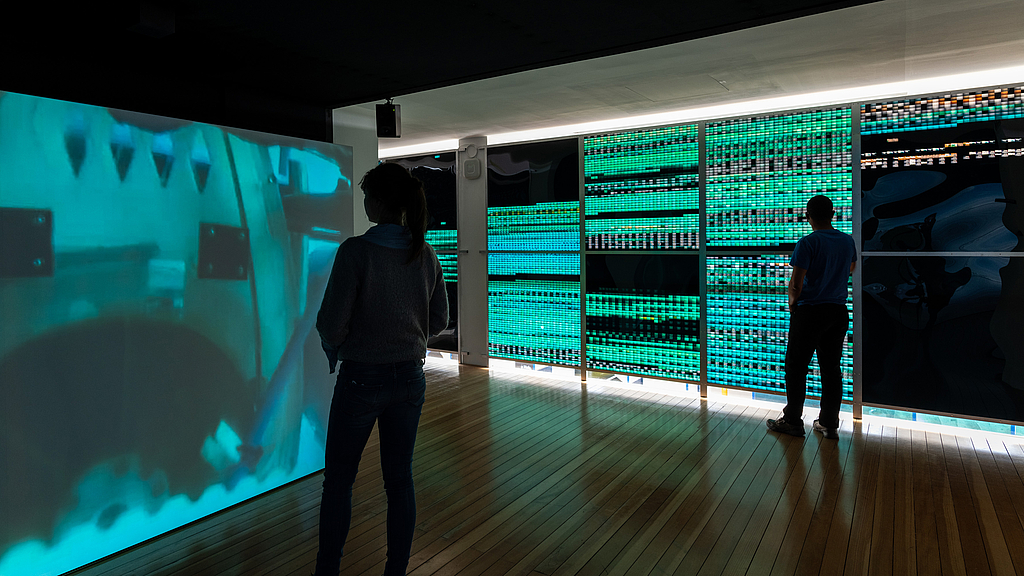LISTENING TO DATA - How the environment gets into the computer
We can neither touch them, nor hear, smell or taste them - data collected via measuring instruments in the sea. Since 2012, the artist Prof. Hannes Rickli has been following the digital data work of biolog:ins investigating the behavior of fish in the Arctic Ocean at the Alfred Wegener Institute, Helmholtz Centre for Polar and Marine Research (AWI). In several installations, he processes the physical emissions of the research equipment, infrastructures and landscapes involved in sounds, images and videos: The exhibition DATEN LAUSCHEN - LISTENING TO DATA will be on view at the German Maritime Museum (DSM) / Leibniz Institute for Maritime History from June 3 to July 31, 2022.
With this artistic installation, the DSM extends the existing exhibitions CHANGE NOW! and INTO THE ICE in the extension building. Both introduce science and research with classical means such as objects, text, documenting images and explanatory graphics. Hannes Rickli's installation is designed as an immersive experience that engages many senses and allows for literal "immersion" in data streams and field research.
The side walls of the gallery on the second floor of the extension building are built into a walk-in archive with large-format picture panels. It shows the chronological progression of the work of a remotely operated underwater station in the Kongsfjord off Spitsbergen, which captured a stereometric image pair every 30 minutes from 2012 to 2020. Fish ecologist Prof. Dr. Philipp Fischer from the AWI observes there how the animal and plant world is changing due to climate change.
Furthermore, streams of electromagnetic noise from the power supply and the cameras as well as sounds from a hydrophone installed at the station can be heard in the installation. The highly sensitive underwater microphone transmits the acoustic backdrop of the environment.
The goal of the Swiss artist is to transfer the raw data of the research medially into the exhibition space and to make it directly experienceable for the audience as images and sounds. Guests are supposed to "feel" the environment of the climate impact research. They "listen" to sounds of ship engines, animals, glacier fractures and iceberg collisions.
When Rickli was doing research for an art project at Lake Constance in 2005, he met AWI scientist Fischer, who was then operating an underwater station RemOs1 in Lake Constance near Konstanz. After this meeting, both developed an interest in media such as photography, audio, computers, etc., which are involved in both biological and artistic research. "As an artist, I take into account the physical materiality of these media, the unheard electromagnetic sounds of the digital devices or the electrical short circuits; all the circumstances that contribute to the production of the scientific data. The analyzed diagrams are urgently needed in the climate debate to understand and socially negotiate processes of change. However, you can no longer see the precarious conditions of their creation on the representations," says the media artist, who teaches at the Zurich University of the Arts.
Rickli and Fischer decided to use the data from the station near Spitsbergen for an art project. "For me, art and science are like two sides of the same coin. It just depends on which side you look at. As a scientist, I extract a numerical quantity from an image or a sound, for example the number of different species of fish, and derive a number from that - diversity. Seen from an artistic perspective, a completely different picture emerges. As a natural scientist, I find this change of perspective fascinating, because it allows us to discover new things beyond our own horizons and to constantly question our own perceptions," says Fischer about the interaction of art and science in the project.
The spatial installation DATEN LAUSCHEN aims to make the research processes in the Arctic regions visible and tangible. Guests can look forward to fascinating visual and sonic experiences and an experimental accompanying program. "The installation uses space as an impact amplifier, flooding eyes and ears with signals from marine research that would otherwise remain hidden. The so-called 'Stereometry Tunnel,' for example, transforms the museum's 60-meter long and only 1.50-meter narrow gallery into a walk-through data stream of more than 270,000 self-illuminating small-format photos," says Christoph Geiger, scenographer at the DSM.
DATEN LAUSCHEN was created in cooperation with the Alfred Wegener Institute, Helmholtz Centre for Polar and Marine Research (AWI) and the Kunstverein Bremerhaven.
Program
04.06.2022 15.00, Curator tour with Hannes Rickli
11.06.2022 18.00 - 24.00 Long Night of Culture, free admission and free tours
-22.00 Presentation of an audiovisual session by kab at the light installation FRAME
08.07.22 19.00, Sound-Walk with Tim Shaw, meeting point: Seaman's Arm DSM
09.07.22 17.00, Sound-Walk with Tim Shaw, meeting point: Theaterplatz
30.07.2022 15.00, Curator tour with Hannes Rickli
For the "SEA SIGNALS SEA SOUNDS" club night at the end of July (date to be announced) with kab (Kreativer Aufbruch Bremerhaven) we are looking for the sound of the sea. Interested parties can either submit their own compositions or use the sound archive to create remixes until June 30. More info: seesignals.art





Data stream tunnel in the exhibition DATEN LAUSCHEN - LISTENING TO DATA.
Photo: DSM / Helena Grebe

